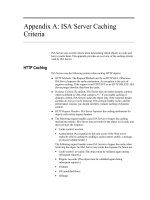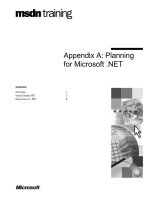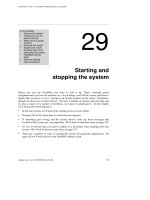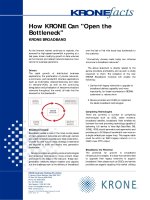Tài liệu Appendix A. Getting and Building the Mozilla Source doc
Bạn đang xem bản rút gọn của tài liệu. Xem và tải ngay bản đầy đủ của tài liệu tại đây (70.15 KB, 22 trang )
Appendix A. Getting and Building the Mozilla Source
One of the best things about using Mozilla as an application development
framework is that you don't need to get involved with the Mozilla source
code to create a Mozilla application. A simple Mozilla binary that you
download and install is the only development platform you need. You can
create and use most procedures and samples described in this book with a
precompiled version of the browser.
The best way to get a working version of Mozilla quickly is to download a
precompiled binary for your platform. If you go to the mozilla.org
homepage, you will find links to Mozilla's most recent stable milestone build
for each platform and a link to the nightly development snapshot builds.
These binaries come as compressed archives or with an installer, and you
can use either to run Mozilla on your computer within a few minutes. These
binaries don't include the source for Mozilla (unless you count the XUL,
CSS, and JavaScript that made up the front end, which are always available),
so read on if you want to obtain the code.
Under the relevant license terms, the Mozilla source code is freely available
to anyone who has an Internet connection and a desire to explore. You may
want to look at this code out of curiosity or dive into the code as you figure
out how it works and can be improved. Whatever your reasons are for
looking at the Mozilla source, it is not much more difficult to get the code
and build it yourself than it is to download the precompiled binaries. To get
started, you need to know a few things about how to get and use the source.
A.1. Getting the Source Code
You can get the Mozilla source code in a few different ways. Depending on
what you are interested in doing, one method may work better for you than
another. This appendix provides basic information about how to get the
source, but you can also find information about this topic on the Mozilla site
at
If you want to look at the source code and don't intend to recompile it,
experiment with it, or update it at all, the best way to get at the source is to
browse the Mozilla code base with Mozilla Cross Reference (LXR). As you
can see in Figure A-1
, LXR is a web-based source code browsing tool
located at . LXR is also hooked up to other tools, such
as Bonsai () and the various tinderboxen
( Together, these tools create a
powerful code maintenance system that is used widely by Mozilla
developers.
Figure A-1. Mozilla Cross Reference code browsing tool
A.1.1. Downloading the Source with FTP
If you would like to get your hands on the code directly, use either File
Transfer Protocol (FTP) or Concurrent Versioning System (CVS) to grab the
source from the Mozilla site. Many people prefer to start by grabbing an
archive of the source code by FTP and then working with CVS as they
modify the code.
If you're sure you won't check your work back into Mozilla and you just
want to get the source, using FTP is the easiest way to do so. The main FTP
server is at (a list of FTP mirrors is available on the
mozilla.org site). To download a particular version of Mozilla, go to either
/pub/mozilla/nightly/latest/ or
/pub/mozilla/releases/, depending on which build you would like
to have.
When you download the source from the releases directory, you get the code
for the most recent Mozilla milestone. These releases are versions of Mozilla
that have been tested and approved by developers at mozilla.org. Milestones
come out about once a month and have some implied stability. The code in
the "latest" directory is for the version of Mozilla currently under
development. This code is not tested and stability is not guaranteed. In fact,
the latest code may not even work if something that was checked in recently
breaks Mozilla.
A.1.2. Downloading the Source with CVS
Grabbing the source with CVS requires additional steps to get things set up
properly, but for many, it's worth the effort. If you would like to contribute
your own changes back to the community, you must understand how CVS
works. Pulling the source in this manner is a good way to start learning
about Mozilla development.
For a quick understanding of CVS, you can obtain a copy of the CVS Pocket
Reference (O'Reilly). To pick up a binary distribution of CVS if it isn't
already installed, go to where
you'll also find links to documentation.
Using CVS requires logging into the Mozilla site by using a CVS client,
checking out the source code, modifying the source code locally, and then
checking the code back into the tree. Anyone is free to check out the code,
but you need special permission to check in the changes you make to the
source. This chapter discusses only how to check out the source with CVS.
You first need a CVS client. Free CVS clients are available for most
operating systems, including WinCVS on Windows and MacCVS for the
Mac. Linux has a command-line CVS client that should come standard on
most Linux distributions. Here are instructions for using the Linux
command-line client to check out the source code:
1. Set the CVSROOT variable:
$ export CVSROOT=:pserver:anonymous@cvs-
mirror.mozilla.org:/cvsroot
1. Log in using the password "anonymous":
$ cvs login
CVS password: anonymous
1. Check out the build Makefile:
$ cvs checkout mozilla/client.mk
U mozilla/client.mk
1. Run the Makefile script to get the files:
$ cd mozilla
$ make -f client.mk checkout
On Windows, the command-line interface used to obtain the Mozilla source
is very similar. You just need to make a few small changes to the steps
above for a Windows install. Here are the steps listed for comparison:
1. Set the CVSROOT variable:
> set CVSROOT=:pserver:anonymous@cvs-
mirror.mozilla.org:/cvsroot
1. Log in using the password "anonymous":
> cvs login
CVS password: anonymous
1. Check out the build Makefile:
> cvs checkout mozilla/client.mk
U mozilla/client.mk
1. Run the Makefile script to get the files:
> cd mozilla
> make -f client.mk checkout
In Step 1, set the CVSROOT environment variable using the set command.
Use the GNU make utility (make) on Windows just as you would on Unix.
Building using nmake is no longer supported on the Mozilla
development trunk, though there is a document describing this process
for developers using older branches at
Before you pull the source code, check the tree status in the relevant
Tinderbox. Grab the source only if the tree is green (success) or yellow
(building). Do not pull the source on red, which indicates that the build is
broken.
To pull the Mozilla source code on Macintosh, use a client like MacCVS,
which automates much of the CVS process for you. Mac OSX users can use
the standard command-line CVS client and pull the source using a method
similar to checking out the source in a Unix environment. Also be sure to
include the required resources XML Perl modules, MacPerl, or the
CodeWarrior development environment which are all listed later in Table
A-1.
The MacCVS client works with session files, which have all the information
and settings you need to pull Mozilla. The settings are listed on the
mozilla.org Mac build page, which even has a ready-made session file that
you can download into the client. Once you set your tools up and configure
your session file for MacCVS, you can pull the Mozilla source by choosing
"Check Out Default Module" from the MacCVS Action menu. Like the
Macintosh build process, pulling the source on Macintosh involves the
interaction of a series of Perl scripts. The PullMozilla.pl script,
located with the other Macintosh build scripts in
mozilla/build/mac/build_scripts, can drive your MacCVS client starting it
up and pointing to the right source, setting the proper variables, and so on.
For more information on the Macintosh build scripts, see
A.1.3. Working with Branching
Branches are distinct Mozilla source code trees that are "cut" to carry out a
specific purpose or used for a milestone release. Developers cut branches
when making large architectural changes that could make the main tree
unstable. Branches in this context allow freer changing and testing off the
main trunk. To work with branches, set the MOZ_BRANCH environment
variable:
> setenv MOZ_BRANCH=MOZILLA_1_0_BRANCH
The value changes according to the repository with which you work. All
other steps can remain the same in the process.
To find out more about using CVS to get Mozilla source and to learn about
what else you can do with CVS, go to
A.2. Building the Source Code
Now that you have the Mozilla source code, what do you do with it? Unlike
the Mozilla binaries that are available for download, you can not start using
Mozilla once you have all the source code on your computer. Before you can
start using the source, you need to set up your working environment and
then build Mozilla.
For the Mozilla source to compile on your computer properly, two main
aspects of your build environment must be set up. These aspects are the
necessary tools and the proper environment variables. You would expect
such a large code base to require a large number of tools, but there aren't so
many. Table A-1
lists the tools you need to build and run the source code.
All information here is presented in more detail at
including links for getting the tools.
Table A-1. Platform tools used to build the Mozilla source code
Linux Windows Macintosh
Linux Windows Macintosh
egcs 1.0.3 (or higher),
gcc 2.95.2
Microsoft Visual C++
Version 6.0 or later
(with service pack 3)
Code Warrior Pro 7
(including Plugin SDK)
GTK+ / Glib 1.2.0
Cygnus toolkit for
Windows (the build
page lists the specific
components)
Menu Sharing Toolkit
1.4
GNU make 3.74
Netscape Wintools
(modified versions of
gmake, shmsdos, and
uname)
ToolServer
Perl 5.005 (or higher) Perl5 for Win32
MacPerl
cpan-mac distribution
Perl AppleEvents
module
Perl Launch module
zip 2.3 (or higher) Zip for Win32
Compress:Zlib module
Archive::Zip module
LibIDL 0.6.3 (or higher)
(Required for static
Linux Windows Macintosh
build)
XML::RegExp
XML::Parser
XML::DOM
Autoconf 2.12 (optional)
The Linux environment is usually set up by default with all the tools listed
for that platform; it therefore requires less time to retrieve and set up
programs. Linux distributions usually come with a native compiler that is
compatible with the Mozilla build system. Most build time is used compiling
the C++ source code the language most files are written in. Therefore, the
compiler is the central component of the build system. Linux uses egcs or
gcc, Windows uses Microsoft Visual C++, and Macintosh uses Metroworks
Code Warrior. The latest version of CVS for each platform accompanies all
tools listed in Table A-1
.
You can set various environment settings for each platform to configure and
optimize your build environment. Most settings are optional and some are
essential. One essential is the CVSROOT variable, which tells the CVS
server where to look for the tree's home or root. The next section looks at the
differences between the Unix, Windows, and Macintosh platforms.
A.2.1. Unix Environment
Unix is probably the easiest platform to configure. In fact, because it's a
developer's platform, it is designed to work with little or no user interaction.
In the source tree, script is provided to do all the work for you. To run it, you
need only the following steps:
> cd mozilla
> ./configure
Running this command gathers all necessary system information and the list
of Makefiles needed to compile the source. This command needs to be run
only when a Makefile is added or removed from the tree. After this, it is
sufficient to compile Mozilla by launching gmake with no arguments.
Alternatively, you can use the Unix Build Configurator, an online tool
( that lets you change certain
settings if you run into any obstacles when building. It allows setting
external package configuration, a choice of Mozilla components, and
debugging and optimization options. Once this setting is made, let Mozilla
take over via the client.mk script:
> gmake -f client.mk
One useful post-build setting is the ability to run Mozilla from any directory
(rather than just dist/bin). To test this option, use
MOZILLA_FIVE_HOME to point to the full path, to the dist/bin, or
wherever your executable resides.
A.2.2. Windows Environment
The setup is different on Windows and requires more interaction on the
user's part, mostly in setting up environment variables. Table A-2
lists these
variables and expected values. Note that some values are optional.
Table A-2. Windows environment variables used to build Mozilla
Variable Value
Descripti
on
MOZ_BITS
32
Specifies
whether
you use a
16-bit or
32-bit
operating
system.
MOZ_DEBUG
1 (optional)
Set only if
you want
a build
with
debug
informatio
n.
Remove
this
variable to
enable it
b
y default.
MOZ_SRC
<path to top of source tree>
The
directory
into which
Variable Value
Descripti
on
you
uncompre
ss or
check out
the
Mozilla
source.
Ensure
that the
path does
not end
with a
trailing
slash (\).
MOZ_TOOLS
<usually the Cygwin root
directory>
The
directory
where
gmake is
installed,
usually
placed
there by
the
Variable Value
Descripti
on
wintools.z
ip package
(refer to
Table A-
1).
WINOS
%OS_TARGET% (see the
OS_TARGET variable)
An
abbreviati
on for the
operating
system
that is also
used
internally
by the OS.
Windows
2000 takes
a value of
WINNT.
It matches
the top-
level
directory
on the
Variable Value
Descripti
on
filesystem
that
contains
all OS
files.
OS_TARGET
WINNT (or WIN95)
A Mozilla
representa
tion of the
OS_TARG
ET
variable
_MSC_VER
1200 (or 1100 for VC++ 5)
The
version of
the
Microsoft
Visual
C++
runtime
environme
nt running
on your
machine.
Variable Value
Descripti
on
The value
of 1200 is
Version 6,
the most
reliable
version.
DISABLE_TESTS
1 (Optional)
Set only if
you do not
want to
build test
directories
and
binaries.
Remove
this
variable to
leave it
enabled
b
y default.
MOZ_DISABLE_JAR_PAC
KAGING
1 (Optional)
Set only if
you want
to turn off
Variable Value
Descripti
on
compressi
on into the
chrome
structure's
JAR files.
Remove
this
variable to
leave it
enabled
b
y default.
MOZ_CONFIG
<path to config file>
This
variable is
required
only for
gmake
builds.
PATH
%PATH%;%MOZ_TOOLS%\bin;c
:\cygwin
The PATH
variable is
an
existing
variable
Variable Value
Descripti
on
that needs
the
Cygwin
root and
binary
directories
appended.
The
operating
system
looks at
this
variable
when
looking
for
program
executable
s and
DLLs.
You can set these variables either by using the set command for per
session variables or the System > Advanced > Environment Variable panel
in Control Panel to set them more permanently.
Once your environment is set and the tools are in place, you can begin
the build. Go to the mozilla directory in the source code and from
there, run the make script (client.mk) with the necessary arguments:
>make -f client.mk build_all
Once your environment is set and the tools are in place, building can begin.
Go to the mozilla directory in the source code and from there, run the
make script (client.mak) with the necessary arguments:
> nmake -f client.mak build_all
Table A-3
lists these arguments and what they do. Leaving out this compile
flag starts an incremental build or a fresh build if there is no previous build
available.
When building incrementally, try to use the provided make script instead of
the cvs checkout and build_all commands. The latter command can
lead to inconsistencies in file versions and may re-download files that you
do not even need to your tree.
Table A-3. Make flags
Flag Function
pull_all
Gets only the source code.
build_all
Builds only the existing source code.
pull_and_build_all
Retrieves the source code and then
builds it.
Flag Function
pull_and_build_all_dep
Does a dependent build after
retrieving the source code. The
source tree is not accessed in a
dependent build.
pull_ clientmak
Pulls only the latest version of the
build file client.mak.
clobber_all
Deletes all files produced from a
previous build to enable a completely
fresh build.
Pull_xpconnect
Retrieves the XPConnect module.
You can retrieve other modules this
way, including nspr and psm.
To rebuild without pulling the tree, use:
> make -f client.mk build_all_depend
To get or update the source code and not build, use:
> make -f client.mk checkout
A.2.3. Macintosh Environment
In terms of environment setup, necessary resources, and actual compile time,
the Mac OS is the least straightforward of the three major platforms Mozilla
builds on. There are several different kinds of Mac builds at mozilla.org, but
this section focuses on just two: the Classic Mac OS 9's standard build,
which has been the default for a long time, and Mac OS X's Code Fragment
Manager (CFM).
Mac OS X builds are becoming more popular as the platform is adopted
more widely. Better performance and native Unix build system tools have
boosted developer support for Mozilla on Mac OS X. However, the
Macintosh is by far the most resource hungry of all platforms Mozilla builds
on. The minimum specification includes 1 GB of disk space and 128 MB of
memory, but you will probably need even more in reality.
To compile the source, check out the module
mozilla/build/mac/build_scripts. Once the download is
complete, go to the folder and run BuildMozilla.pl for an optimized build or
BuildMozillaDebug.pl for a debug build. Running the CodeWarrior
environment during or before running build scripts is useful. When you run
the build script, you will be asked for the location of CodeWarrior, if it is not
already running. You can change some build options through a local
preferences file, which can be found in the system preferences folder for
system variables or at the root of the Mozilla tree for tree-specific variables.
You can find more information on fine-tuning the build at
When the compile is complete, you need to take an extra step to start it.
Mozilla needs certain things set properly so it can gather the information it
needs at runtime. Traditional Mac OS systems have no concept of
environment variables per se, but one alternative is to use a startup file
called NSPR Logging that comes with Mozilla in the same directory as the
application. Its lines are in the following format:
ENV:NSPR_LOG_MODULES=nsComponentManager:5
ENV:NSPR_LOG_FILE=xpcom.log
Dragging this file onto Mozilla starts the application with those settings.
You can edit this file by adding or changing the ENV lines or make another
file. This modification method is useful for single session settings. For more
permanent settings, you can create a file called ENVIRONMENT and put it
in the same folder as Mozilla. Mozilla picks up the environment variables in
the ENVIRONMENT file when it runs. The file contents look something like:
NSPR_LOG_MODULES=nsComponentManager:5
NSPR_LOG_FILE=xpcom.log
The Mac OS X CFM version uses the same build system as OS 9. If you
build, you need to adjust the following setting in order to build with Carbon,
which is a set of APIs that transition developers from OS9 and earlier
releases to the new OS X system architecture:
In your Prefs folder, add the following line to the
Mozilla[debug/opt] build prefs file:
options carbon 1
For more information on pulling the Mozilla source on OS X, the OS X
build process, and other OSX Mozilla resources, see









